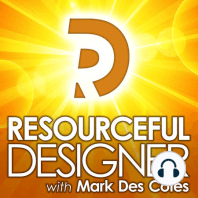35 min listen

The Psychology Of Pricing: Part 5 – RD268
FromResourceful Designer: Strategies for running a graphic design business
The Psychology Of Pricing: Part 5 – RD268
FromResourceful Designer: Strategies for running a graphic design business
ratings:
Length:
26 minutes
Released:
Aug 23, 2021
Format:
Podcast episode
Description
This is week five of my Psychology of Pricing series. Where I share research-proven strategies to help the prices you display convert into sales. Some of these pricing tactics work great with your design business, and many of them are perfect for helping your clients get more sales. So if you haven’t read or listened to the previous parts in this series, I suggest you do so before continuing with this one. The tactics I’m sharing here are taken from a very in-depth article called The Psychology of Pricing by Nick Kolenda. You can find it on his website. Let’s get on with the list. Tactic 35: Place Low Numerals After Right-Facing Digits. As a designer, you know how to create flow in a design. For example, If a person is looking to the right, you want to put their photo on the left of a layout. If they’re facing the left, you want them on the right of the layout. This creates flow in the direction you want people to focus on. There are many ways to create flow in a layout besides which direction a person is facing. One of the ways you can do it is with numbers. A 2007 study determined that certain digits face particular directions. 2,3,4,7,9 face the left. 1,8,0 face centre. 5,6 face right. Rightward digits 5 & 6 push attention towards the right. When used in a price, they push attention towards the digits that follow them. Since customers tend to round numbers up or down, you’ll want to place a lower number next to a right-facing digit causing customers to round down the price. Conversely, leftward digits, 2,3,4,7 & 9 push the attention towards the left. This means that customers may ignore a large number placed to the right of them. Tactic 36: Insert Alliteration into Prices. Alliteration is the repetition of similar initial sounds within a group of words. Such as Karl craves coconut cookies with a repetitive hard "C" sound. There’s something about alliteration that feels good. It feels right. And that feeling can be misattributed towards another context. A 2016 study found that customers were more likely to buy products when alliteration was used. For example, “Two T-Shirts for $20.” The repetitive “T” sounds make the purchase feel right. Tactic 37: Use Round Prices in the Right Context. Rounded prices, those that don't display cents, should be used for emotional purchases. Non-rounded prices, those that display cents, should be used for rational purchases. There are three contexts when you should consider using round prices. 1) Emotional Purchase. Because round prices “feel right,” they are good for emotional purchases over rational purchases. A 2015 study found that customers prefer buying something such as a bottle of champagne for a rounded price such as $40. Whereas when buying something such as a calculator, they would prefer a non-rounded price of $39.72. 2) Convenience Purchases. Round prices that “feel right” also trigger an “easy” sensation. Making a transaction seem easy and a good choice. A 2016 study found that using round prices on point-of-sale items at a checkout counter increased sales. 3) Social Benefits. Customers prefer round prices for social products. Since round numbers are easily divisible, people confuse numerical connectivity for social connectivity. For example, charging $457.99 for a four-day conference may seem expensive to someone because they see it as a high price for one social benefit. However, charging $400 for a four-day conference makes it easy for people to think of it as $100 per day, which may sound more reasonable to them. Tactic 38: Distinguish the Most Expensive Option. This tactic works great with the three-tiered pricing method when quoting design projects. In a previous part of this series, I said you should sort prices from high to low. But there are ways around that. As designers, you know that design can have a hierarchy. A good designer knows how to lead a viewer's eye from one design section to another in a predefined path. So instead of putting the highest price first, you
Released:
Aug 23, 2021
Format:
Podcast episode
Titles in the series (100)
8 Myths About Starting A Home Based Design Business-RD006: 8 Myths About Starting A Home Based Design Business. If doesn't matter if you're a graphic designer or a web designer, it's all the same when it comes to starting a home based design business. To some, the thought of starting their own home based... by Resourceful Designer: Strategies for running a graphic design business